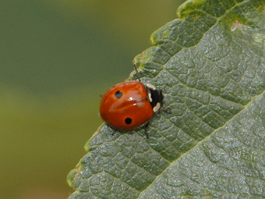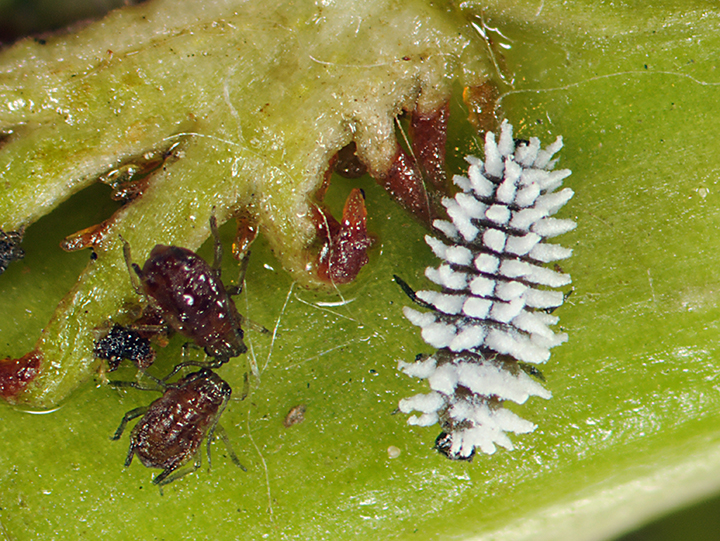(Coleoptera: Coccinellidae)

About 400 species of lady beetles are found in North America. Several species have been introduced to control pests. Almost all lady beetles prey, as both larvae and adults, on soft-bodied pests such as aphids, mites and scales.
One larva can consume hundreds of prey during its development. Because of their voracious appetites and ability to multiply rapidly, lady beetles can control even large infestations of pests. They are important predators of orchard pests, especially aphids. The two most common species in the Northwest are the convergent and transverse lady beetles.
Convergent lady beetle
Hippodamia convergens Guérin-Méneville
Hosts
Larvae and adults will feed on most small soft-bodied insects but prefer aphids.
Life stages
Eggs

The egg is bright yellow, elongated and pointed at one end. It is about 1/16 inch (1.5 mm) long. Eggs are laid in clusters, usually on the bark or leaves of tree infested with prey.
Larva
The alligator-shaped larva is dark gray with two small, often indistinct, orange spots on the prothorax and four larger ones on the back. It develops through four instars and when mature is between 1/4 and 3/8 inch (7 to 10 mm) long.
Pupa
The pupa is orange and black and almost hemispherical. It is most often found attached to the upper surface of a leaf.
Adult
The adult is 1/4 inch (6 to 8 mm) long. While the body is black, the forewings, which cover most of the body, are orange to red with 12 black spots. Just in front of the forewings, or elytra, is the prothorax, which is black with two oblique (converging) white stripes and white edges. Its small head is almost covered by the front of the thorax. Legs and antennae are short.
Life history

Convergent lady beetles are effective predators in spring. They overwinter as hibernating adults, usually in mountainous regions. Large concentrations are often found in the same area each year. In spring, the beetles return the valleys. After mating, females seek out a good location for their offspring, usually a tree infested with aphids that ensures a plentiful food supply for the larvae. Eggs are laid only after adults have fed on prey.One female can lay between 200 and 500 eggs, depending upon the availability of prey. Eggs hatch in 5 to 7 days. The young larvae devour prey as fast as they can find them. The life cycle from egg laying to adult takes 4 to 7 weeks, depending on the temperature and amount of food available. There are typically 1 or 2 generations per year. Populations are higher in the first generation. In late summer, adults migrate to mountain areas to hibernate.
Transverse lady beetle
Coccinella transversoguttata richardsoni Brown
Hosts
The transverse lady beetle attacks aphids of apples and stone fruits and other soft-bodied insects such as pear psylla.
Life stages
Egg

The egg is yellowish orange and spindle shaped, similar in size and appearance to that of the convergent lady beetle.
Larva
The larva is blue-black with orange markings and is alligator shaped.
Adult
The adult is 1/4 inch (6 to 7.5 mm) long. It is more rounded in shape than the convergent lady beetle and has fewer spots on the elytra. While the body is black, the dominant color is the orange of the elytra which covers most of the body.
Life history
The transverse lady beetle has 1 to 3 generations in the Pacific Northwest. It is one of the first predators to arrive in orchards in the spring. Overwintering adults may be observed as early as March. Eggs and larvae appear from mid-May to June, and new adults emerge in late June and July. Larvae can often be seen in orchards as late as mid-September.
Monitoring
The beating tray is the most widely used method of monitoring lady beetle adults. Densities of larvae and pupae can be estimated while making visual counts of pest populations.
Management
Avoid using broad-spectrum insecticides that are toxic to lady beetles. Supplies of adults can be bought for release in orchards but they often disperse when aphid populations are low. Releases of lady beetles in the orchard in mid- or late summer are unlikely to be very beneficial.
Black lady beetle
Stethorus picipes Casey
These small lady beetles prey chiefly on mites. S. picipes is usually found in orchards with heavy spider mite or rust mite populations and generally does not appear in orchards until mite populations are quite high.
Distribution of black lady beetles is patchy, and they generally are not as closely associated with their mite prey as are predatory mites. Although they may be useful in reducing high mite populations, they cannot be relied upon to maintain phytophagous mites at a low level on a long-term basis.
Life stages
Egg

The egg is gray, tiny and spindle shaped. Eggs are laid singly in mite colonies.
Larva
The larva is about 1/20 inch (1 to 1.5 mm) long and is dark brown or black with short spines.
Pupa
The pupa is mahogany colored and usually attached to a leaf surface.
Adult
The adult is black and covered with silvery hairs. It is about 1/25 inch (1 mm) long, much smaller than the transverse or convergent lady beetles.
Scymnus spp.
The genus Scymnus includes many species of small black, brown, mottled or spotted beetles. The larvae are usually covered with a white wax and are often mistaken for mealybugs. They feed on mealybugs, scale insects, aphids, red spiders, mites and insect eggs. Adults are about 1/12 inch (2 mm) long.
Mealybug destroyer
Cryptolaemus montrouzieri Mulsant
This introduced species of lady beetle can be an effective predator of mealybugs and will also feed on soft scales and aphids. Both adults and larvae are predaceous. Adult beetles are black with orange markings on the head, thorax and tip of the elytra and are about 1/6 inch (1 mm) long. Larvae are covered with white waxy filaments giving them an appearance similar to their host. The small orange eggs are laid within mealybug colonies. A single generation can be completed in as little as 30 days during the summer.
Cryptolaemus are raised primarily as a control agent for the citrus mealybug in California. They are generally released as adults in the early spring when mealybugs become active. Cryptolaemus montrouzieri has been evaluated as a potential biological control for the grape mealybug in pear and apple in Washington.



